An Old Testament KnoWhy[1]
Gospel Doctrine Lesson 14:
“Ye Shall Be a Peculiar Treasure Unto Me”
(Exodus 15-20; 32-34) (JBOTL14A)
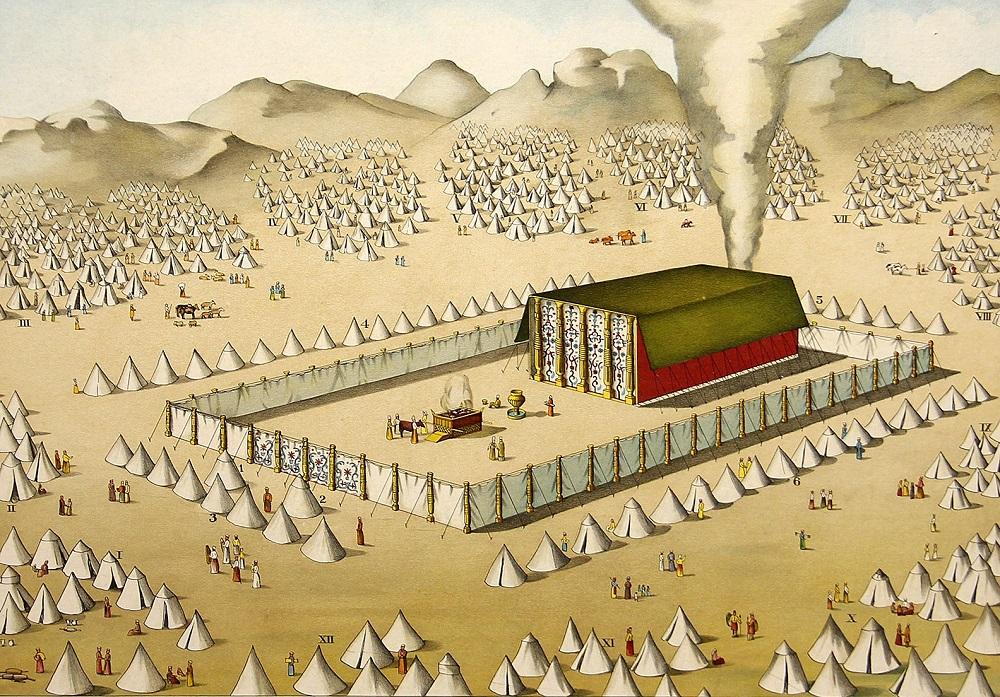
Figure 1. Israel Camped Around the Wilderness Tabernacle[2]
Summary: Temple rituals in the ancient Near East may seem in some respects far removed from current LDS teachings and ritual practices. However, what resemblances exist may be of significance to a people who claim that divine revelation about the ordinances go back to the beginning of mankind. Predating, as they do, the Israelite Tabernacle by more than a millennium, such resemblances may be “an embarrassment to exclusivistic readings of religion.”[3] However, to Mormons they represent “a kind of confirmation and vindication.”[4] Thus, Egyptian and other ancient temples should be better understood by Latter-day Saints. For although, as Hugh Nibley observed, “the Egyptian endowment was but an imitation, it was still a good one, and we may be able to learn much from it.”[5]
The Know
Among other works of scripture, the book of Exodus is exceptionally rich — so rich that it can be studied profitably from several different perspectives. For instance, in a previous article in this series, I explored some of the issues and findings relating to the historical setting of Exodus. Additional scholars have focused attention on different issues such as typology — how authors and editors elsewhere in the Bible and the Book of Mormon later “liken[ed]”[6] their own situations to the story of captivity and deliverance in the book of Exodus.[7] Yet others have explored implications of the magnificent literary unity of Exodus (in its current form) from diverse angles.[8]
However, it would be nothing short of irresponsible to discuss the book of Exodus without commenting on its many temple themes. Several chapters of Exodus are taken up in describing the architecture and furnishings of the Tabernacle. In addition, there is a lengthy account of Israel at the foot of Mount Sinai, a “temple” of God’s own making.[9]
The Antiquity of Temple Ordinances
Joseph Smith taught that the origins of modern temple ordinances go back beyond the foundation of the world. For example in 1835, as the Saints prepared to receive the ordinances that would be available to them in the Kirtland Temple, the Prophet stated:[10]
The order of the house of God has been, and ever will be, the same, even after Christ comes; and after the termination of the thousand years it will be the same; and we shall finally enter into the celestial kingdom of God, and enjoy it forever.
While, as Joseph Smith taught, the “order of the house of God”[11] must remain unchanged, the Lord has permitted authorized Church leaders to make adaptations of the ordinances to meet the needs of different times, cultures, and practical circumstances. Latter-day Saints understand that the primary intent of temple ordinances is to teach and bless the participants, not to provide precise matches to texts, symbols, and modes of presentation from other times. Because this is so, we would expect to find Joseph Smith’s restored ritual deviating at times from the wording and symbolism of ancient ordinances in the interest of clarity and relevance to modern disciples. Similarly, we would expect various adaptations in the presentation of the ordinances to mirror changes in culture and practical circumstances.
Other innovations and adaptations of temple ceremonies have been made under conditions of lesser inspiration. For example, Hugh Nibley taught that the Egyptian rites “are a parody, an imitation, but, as such, not to be despised”[12] because they were “good imitations” and undertaken in some cases with a degree of righteous intent. For example, we read in Abraham 1:26-27 that “Pharaoh, being a righteous man,” sought “earnestly to imitate that order established by the fathers in the first generations, in the days of the first patriarchal reign,” for he “would fain claim” the priesthood.
Of course, we cannot hope to do justice to the topic in the few pages of this article. The hope is to introduce a small sampling of general affinities between Egyptian and Israelite temple architecture and ritual — realizing of course that significant details varied over the centuries.
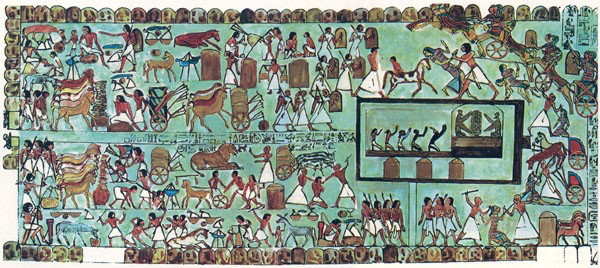
Figure 2. Ramesses II’s war camp at the Battle of Kadesh as reconstructed from a relief on the north wall of the Great Hall at the Abu Simbel Temple. The camp is surrounted by leather shields and is oriented eastward. Note the throne Tent of Ramesses II at right. In the sanctuary, winged Horus falcons flank the cartouche containing the pharaoh’s name, recalling the cherubim atop the Ark of the Covenant.[13]
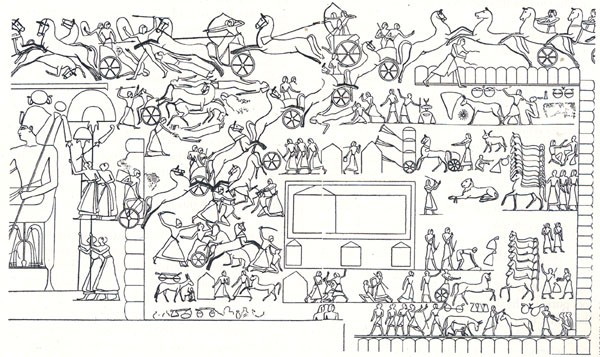
Figure 3. Ramesses II’s war camp as depicted on a pylon at the Luxor Temple[14]
Egyptian Parallels to Tabernacle Layout, Architecture and Functions
Ramesses II’s war camp at the Battle of Kadesh. We begin with a close look at the Egyptian war camp scenes at the Battle of Kadesh. Michael M. Homan describes the scenes shown above as follows:
All four reliefs depict Ramesses’ camp as rectangular, its perimeter lined with large leather shields standing side by side. At the center of the camp is a rectangular tent. In the courtyard horses are being harnessed to chariots, soldiers are being fed, and the wounded are being treated. In the lower-right-hand corner of the camp as it is depicted in the Abu Simbel relief, a captive who falsified reports concerning the position of the Hittite forces is being beaten; the Hittite chariotry is shown breaking into the camp immediately above.
An unprecedented effort at realism characterizes these pictorial records—perhaps owing to the indelible impression left by such a narrowly averted military and political disaster. For example, each relief depicts Ramesses’ pet lion relaxing outside the tent in the center of camp. Even more striking, the images of the soldiers in the pharaoh’s army, in contrast to typical Egyptian battle scenes, are no larger than the images of their enemies. Similarly, while the pharaoh himself is not depicted, the pharaoh’s cartouche, displayed in the pharaoh’s tent in the Abu Simbel relief, is no larger than the warriors. As the distinguished Egyptologist Gaballa Ali Gaballa wrote, “The scenes of the battle of Qadesh constitute, undoubtedly, the zenith of all … attempts and ventures of the Egyptian artist [up to that time] to give a specific rendition of a specific event.”
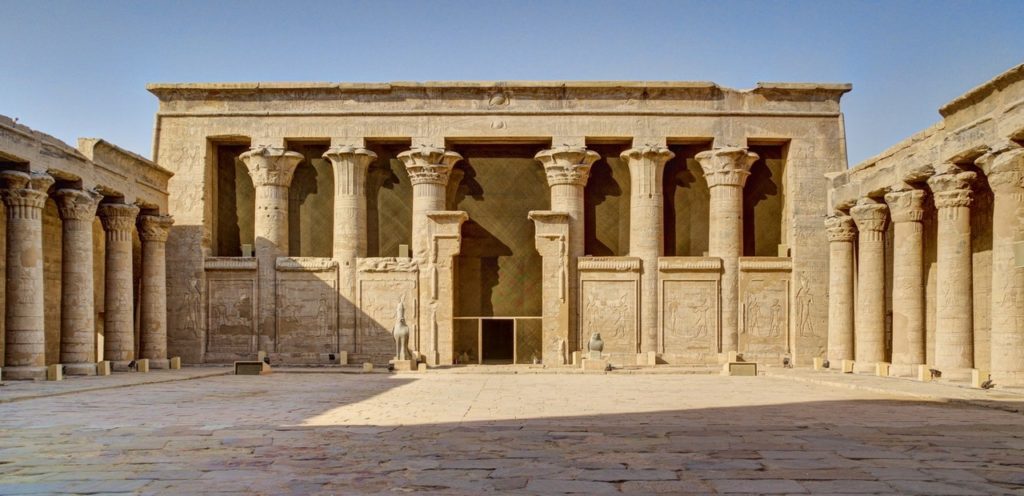
Figure 4. Interior Courtyard of the Temple of Horus at Edfu.
Photograph by Stephen T. Whitlock.
Resemblances to the camp and Tabernacle. Of significance for the topic of the present article are the findings of scholars such as Homan[15] and Myung Soo Suh,[16] that the layout of the camp and war tent of pharaoh closely resembled the camp and tabernacle of Israel. Similar comparisons, of course, could be made with permanent Egyptian and Israelite temple structures. For example, John Gee has written a study comparing the Tabernacle of Exodus with the Egyptian temple of Edfu. He concluded that there must be “some connection between an early form of the [Egyptian] Book of the Temple and the book of Exodus.”[17]

Figure 5. Comparison of the Layout and Proportions
of Ramesses II’s Camp, the Tabernacle, and the Temple of Solomon[18]
The parallels between Ramesses’ camp and the biblical Tabernacle, beginning with the dimensions, are striking. In each of the reliefs, Ramesses’ camp forms a rectangular courtyard twice as long as it is wide. The main entrance to the courtyard is located in the middle of one of the short walls. A road leads from this entrance to the first of two adjacent tents, the so-called reception tent, the entrance to which lies directly in the middle of the courtyard. The length of the reception tent is twice its width (and, judging from the Abu Simbel relief, its height). The reception tent leads into the pharaoh’s throne tent, which is square, each side being equal to the width of the reception tent. The tent and the camp lie on an east-west axis, with the entrance to the east. Although the orientation is not clear in the reliefs, an inscription at the Ramesseum records that the Hittite chariots pursued the Egyptian princes to the west end of the camp, that is, the camp’s back side.
How does this compare with the desert Tabernacle? The Tabernacle is encompassed by a rectangular courtyard 100 cubits in length and 50 in width, mirroring the 2:1 ratio found at Ramesses’ camp. Like the Egyptian camp, the Tabernacle is oriented east-west, with the entrance to the courtyard in the middle of the eastern wall. The Tabernacle entrance lies directly at the center of the courtyard. The first room consists of a forechamber, the length of which is twice its height and width. The second room, the holy of holies, is a cube, the measurement of each side equaling the width of the forechamber.
The similarities reach beyond the ground plan: At Abu Simbel Ramesses II’s cartouche, in the inner tent, is flanked on either side by a representation of the winged falcon god Horus; the birds’ wings cover the pharaoh’s golden throne. In the innermost room of the Tabernacle, the wings of two cherubim cover Yahweh’s golden throne.
The military function of the Tabernacle. The parallel between the Pharaoh’s war tent and the Israelite Tabernacle may seem strange until one realizes that the Tabernacle “not only functions as a cultic device but also as a military headquarters and the ark is both a palladium for holy war and a cultic object.”[22] In a book-length study, Myung Soo Suh gives many examples of why this parallel makes sense, but here we will cite just one example, an example that may clarify a difficult-to-understand detail of the Exodus story:[23]
The despoiling of the Egyptians during the exodus always seems to be a strange motif if one stops reading after the great events of the exodus. Focusing on the Tabernacle, Suh demonstrates that the metal spoils taken from the Egyptians provide the material basis for constructing the Tabernacle. The golden calf, however, was the wrong way to use the jewelry taken from the Egyptians;[24] hence this important episode was placed between the instructions to build the Tabernacle and the Ark in Exodus 25:31 and the execution of these instructions in Exodus 35:40. Suh discovers an antitypal parallel between Exodus 25:31 and Exodus 32.
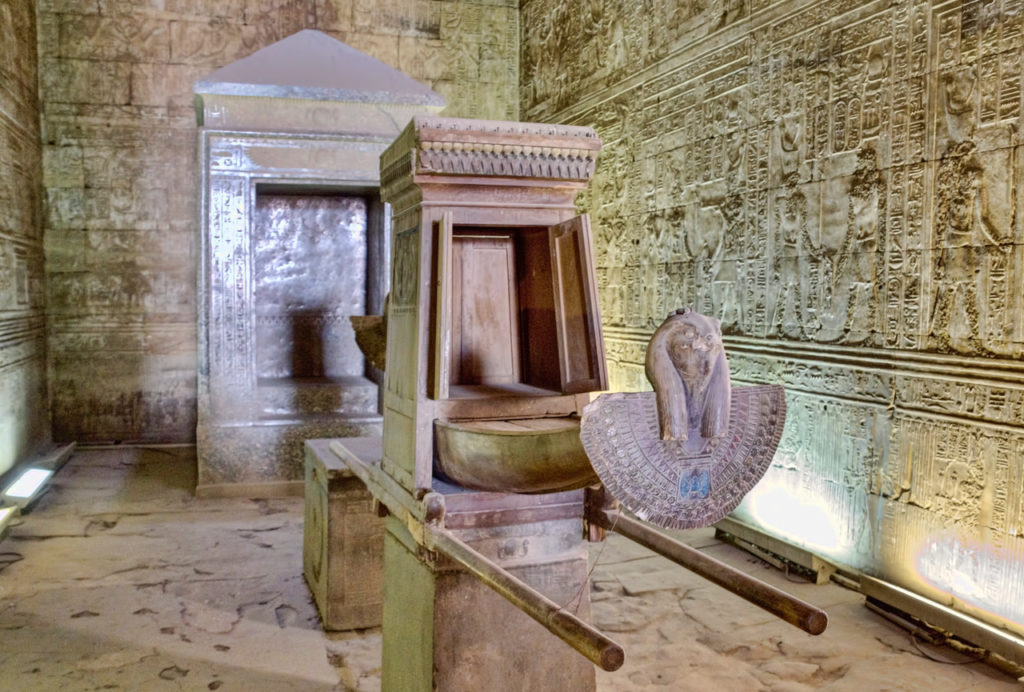
Figure 6. Reproduction of the barque (boat) shrine in the innermost sanctum of the Temple of Horus at Edfu, the Egyptian equivalent of the Israelite Holy of Holies. Behind the Barque is the shrine where a golden statue of Horus was kept. Each year during the annual festival, the statue of Horus would be placed in his Barque to join the Barque of Hathor in a celebration of their sacred wedding.
Photograph by Stephen T. Whitlock
Parallels between the barque and the Ark. Going one step further than Homan’s analysis of the Tabernacle itself, Scott B. Noegel[25] has shown:[26]
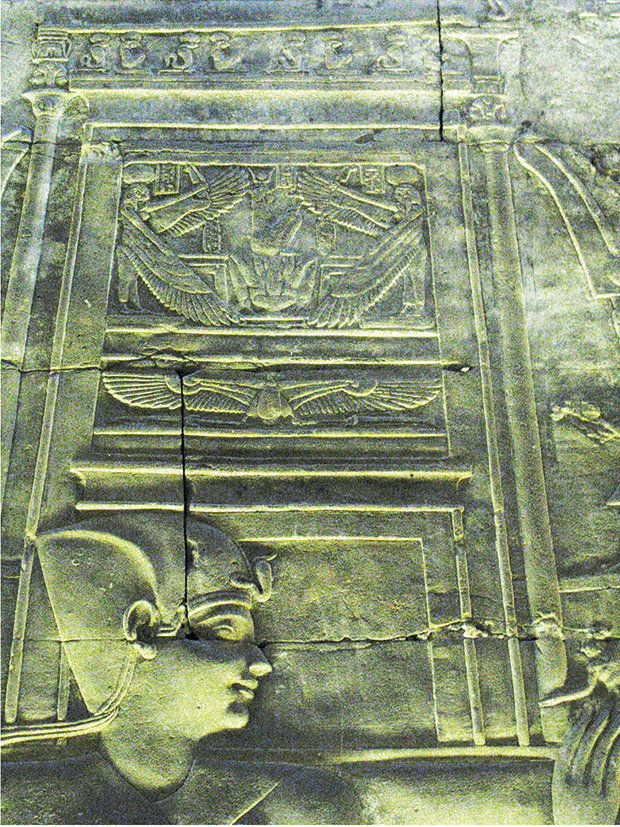
Figure 7. Protective cherubim decorate the barque shrine of the Temple of Horus at Edfu[28]
parallels between the Levite priests’ description of their Ark of the Covenant and Egyptian barks. Though barks are boats, these barks were rarely set in water. They were rather carried in processions. They were sacred ritual objects. Like the ark that the Levites carry in Israel, the barks were sometimes gold-plated, many were decorated with winged cherubs or birds, they were carried on poles by priests, and they served as a throne and footstool. Noegel concluded that “the bark served as a model, which the Israelites adapted for their own needs.”[27]
Of course, Noegel recognized that to the Israelites, the Ark of the Covenant was not, in fact, a barque:[29]
The Israelites conceived of the Ark not as an Egyptian boat with a prow and stern and oars, but as a rectangular object, more akin to the riverine boat that informs the shape of Noah’s Ark.[30] Nevertheless, some of the bark’s other aspects remained meaningful in Israelite priestly culture. It still represented a throne and a footstool and so it still served as a symbol of the divine presence. It continued to be a sacred object that one could consult for oracles, and its maintenance continued to be the exclusive privilege of the priests.

Figure 8. Drawing of an Initiation Sequence from a temple at Karnak, ca. 320 BCE. “This sequence … shows how the royal initiation culminated in ritual embraces. In each scene the words of instruction are written over the heads of the speakers.”[31] Photograph by Stephen T. Whitlock[32]
A notable student of ancient and modern temple ordinances in our day was Hugh W. Nibley, a Brigham Young University professor and internationally respected scholar of ancient cultures. Speaking of his own endowment in 1927, he remembered: “I was very serious about it … And the words of the initiatory [part of the endowment] — I thought those were the most magnificent words I have ever heard spoken.”[33] Admitting that his first visit to the temple had left him “in something of a daze,” his return to the temple after his mission was an overwhelming experience: “At that time I knew it was the real thing. Oh, boy, did I!”[34]
Nibley’s delight in knowing that the ordinances he received were the “real thing” was not only because he felt and understood the power of the temple personally but also because he recognized that many of the teachings and forms used in modern ordinances resonated with what he already knew about ancient temple worship. Nibley remained a devoted participant and student of the temple throughout his life. His writings drew on his extensive knowledge of the ancient world and illuminated many aspects of restored temple ordinances. He was particularly enthralled with tracing Egyptian rites backward to their earliest surviving traces:[35]
The exercise can be carried back to the Pyramid Texts, the oldest large body of religious writings to survive. This large and disorganized collection does not allow for a neat overall comparison, but all the main themes are there — and no others — indicating that the story begins as it ends, with the same plot and characters. If we take all the topic headings assigned to the various Pyramid Texts by Raymond Faulkner in 1969, we find that they fall readily and completely into six main categories: namely, (1) the importance of a primordial written document on which the rites are based; (2) purification (including anointing, lustration, and clothing texts); (3) creation (the common resurrection and awakening texts); (4) garden (including tree and ritual-meal motifs); (5) travel (protection, “ferryman,” combat, and Osirian texts); and (6) what Faulkner calls “ascension” texts (including victory, coronation, admission to the heavenly company, and Horus texts). These six themes are basic to the mysteries everywhere.
Referring the readers curious for more detail to the extensive explanations of Nibley, here we will give brief, published descriptions of the Karnak sequence without further comment.
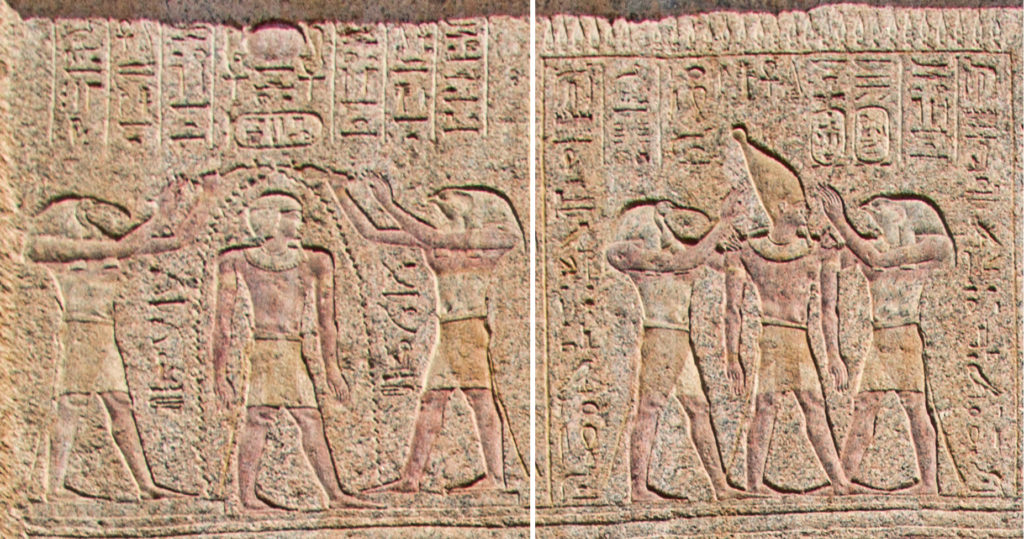
Figures 9a, b. “First comes the washing or baptism, then (in another room) the bestowal of crown and throne.”[36]
Photograph by Stephen T. Whitlock
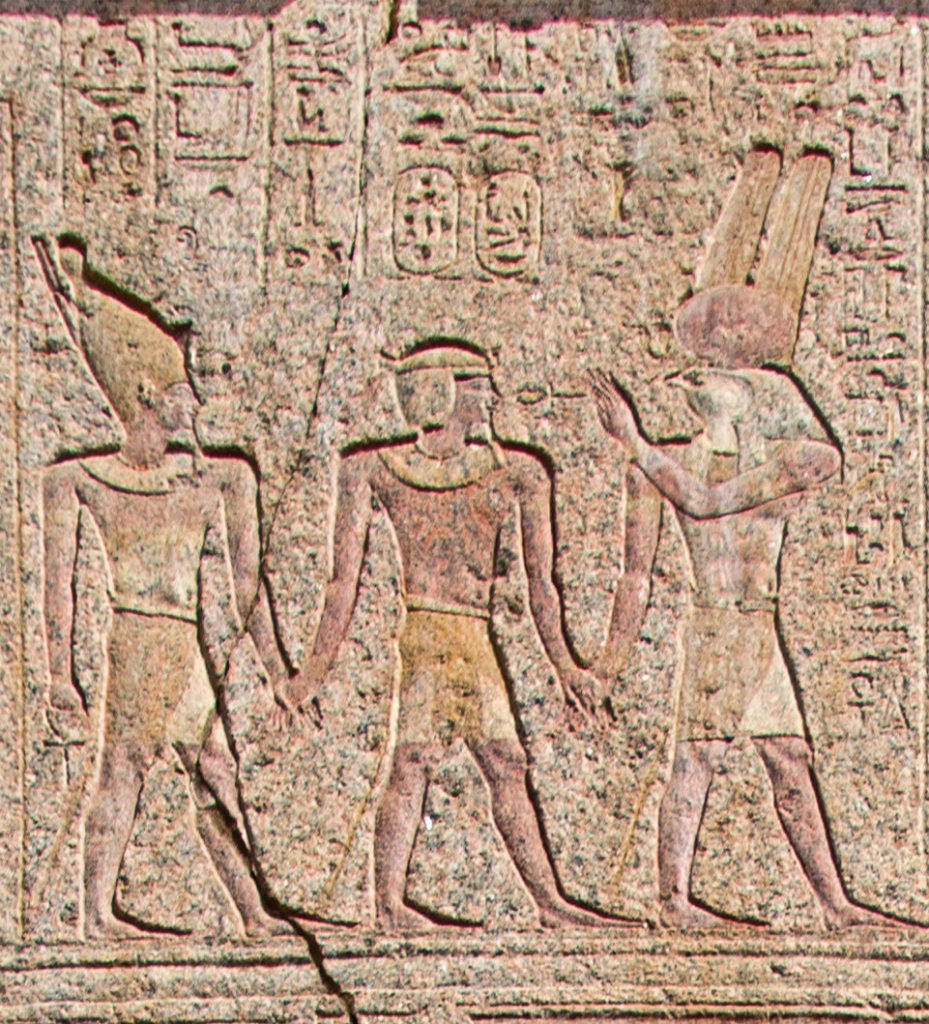
Figure 10. “The candidate is conducted by ministers of ‘life, health, strength, and joy’ to Thoth the [Master of Ceremonies].”[37]
Photograph by Stephen T. Whitlock

Figure 11. “Thoth … introduces him at the last shrine, the maternal embrace of Innt, who says, ‘I nurse thee with my milk.’ Thus the rites end in the intimate embrace of the primordial family.”[38]
Photograph by Stephen T. Whitlock.
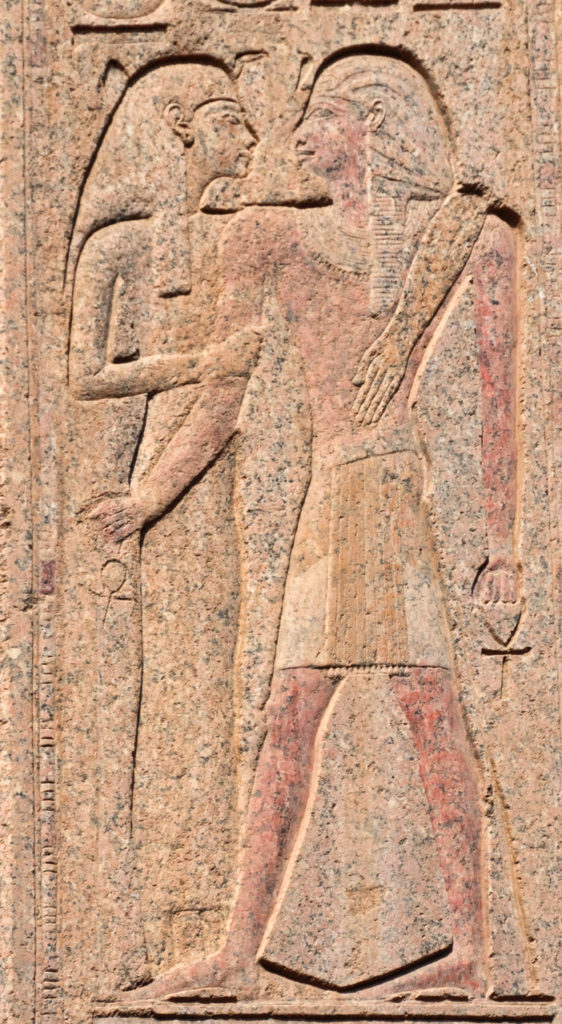
Figure 12. A similar relief at Karnak is described as follows: “The last king of the 25th Dynasty receives the royal embrace from Amun-Re. … The characters on the right [not shown here] are various symbols of embracing.”[39] “The two arms [of the selkit ideogram here] are embracing, and they are embracing the djed symbol, which represents the marrow in the bones.[40] This is called ‘health and strength.’ He says here, ‘I give thee all life and power.’ This is a picture of the symbol for life — actually the umbilical cord, the navel. The other is [the] was [scepter], which is always rendered as ‘power in the priesthood, authority to speak for the priesthood, etc.’ Also, when he went forth, according to Moet, they embraced him on either side. The kings always had those two fans called the shuit or the khaibit. This is the counterweight which hangs on the breast to impart breath and life.” [41]
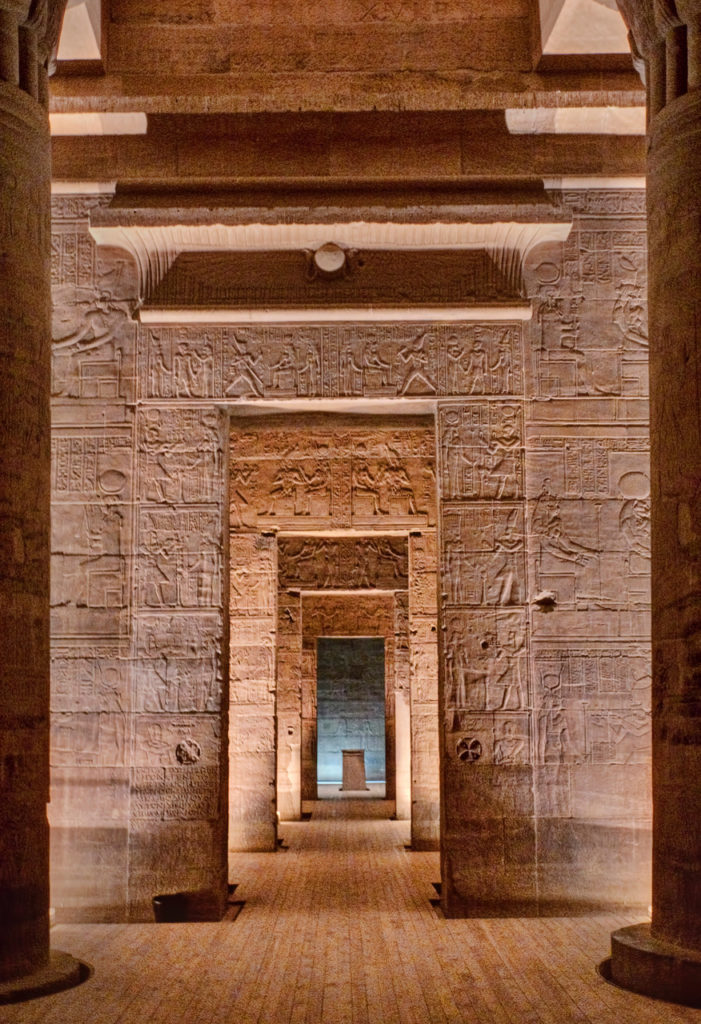
Figure 13. Temple of Isis, Philae, Egypt, 380–362 BCE. Passage through an ascending sequence of spaces of increasing holiness by means of a series of narrow doors or gateways is a near-universal feature of ancient temples. The degree of sacredness and the difficulty of access increases as one approaches either the innermost or topmost space.
Photograph by Stephen T. Whitlock
The Why
While affirming the value of learning what we can about the “Egyptian endowment,” Hugh Nibley realized that it would not “make the Latter-day Saint temple endowment more ‘meaningful’ to the reader — nothing could do that. … What these few bits of added information do is to supply a new dimension to the experience, along with the assurance that a wealth of newly found records confirms the fundamental thesis of its antiquity and genuineness.”[42]
If, then, the endowment is ancient and genuine, could Joseph Smith have derived it from gathering together bits of lore from Egypt and elsewhere? Nibley gives his own answer, and mine, to the question as follows:[43]
There are, in fact, countless tribes, sects, societies, and orders from which he might have picked up this and that, had he known of their existence. The Near East in particular is littered with the archaeological and living survivals of practices and teachings which an observant Mormon may find suggestively familiar. The Druzes would have been a gold mine for Smith. He has actually been charged with plundering some of the baggage brought to the West by certain fraternal orders during the Middle Ages — as if the Prophet must rummage in a magpie’s nest to stock a king’s treasury! Among the customs and religions of mankind there are countless parallels, many of them very instructive, to what the Mormons do. But there is a world of difference between Ginzberg’s Legends of the Jews and the book of Isaiah, or between the Infancy Gospels and the real Gospels, no matter how many points of contact one may detect between them. The Latter-day Saint endowment was not built up of elements brought together by chance, custom, or long research; it is a single, perfectly consistent, organic whole, conveying its message without the aid of rationalizing, spiritualizing, allegorizing, or moralizing interpretations.
As always, I appreciate the love, support, and advice of Kathleen M. Bradshaw on this article. Thanks to Stephen T. Whitlock for allowing me to include his beautiful photographs and for other valuable suggestions.
Further Study
Michael M. Homan (M. M. Homan, Divine Warrior; M. M. Homan, To Your Tents; M. M. Homan, Tabernacle) and Myung Soo Su (M. S. Suh, Tabernacle) have produced in-depth studies of Egyptian precedents for the Tabernacle. See S. B. Noegel, Egyptian Origin for an in-depth comparison between the Egyptian barque shrine and the Ark of the Covenant.
John Gee has written an instructive chapter on Edfu and Exodus (J. Gee, Edfu and Exodus). A video of his presentation at the Interpreter Foundation 2012 Temple on Mount Zion Conference is available at https://www.youtube.com/watch?v=2lEIm3oGPoY.
For Hugh Nibley’s book-length study of what he called the “Egyptian Endowment,” see H. W. Nibley, Message (2005).
For studies of the origins of the modern LDS temple ordinances, see J. M. Bradshaw, Freemasonry; J. M. Bradshaw, What Did Joseph Smith Know. For a video of “What Did Joseph Smith Know about Temple Ordinances by 1836?” from the Interpreter Foundation 2014 Temple on Mount Zion Conference, see https://www.youtube.com/watch?v=UhQWrMXt2Mc.
An excellent short video discussing the Tabernacle and the Messiah is available from Daniel Smith at https://www.youtube.com/watch?v=TygiChDYd4Y. See also his presentation on “The Ancient Israelite Tabernacle, Its Accoutrements, and the Priestly Vestments,” given at the Interpreter Foundation 2016 Temple on Mount Zion Conference, 5 November 2016, Provo, Utah (https://www.youtube.com/watch?v=rEb4u4OB-aU).
On 7 October 2015, Joshua Berman gave a talk for the Academy for Temple Studies on “Differences between the Tabernacle and the Temple,” https://www.youtube.com/watch?v=LB6xlYpcO-w. He gave a similar talk on 8 October 2015 at the BYU Kennedy Center, https://www.youtube.com/watch?v=15ew7on3UL4 and https://www.youtube.com/watch?v=K3nw2C1J5Lg.
Berman published an article entitlded “The temple: A multi-faceted center and its problems” in Interpreter: A Journal of Mormon Scripture (J. A. Berman, Temple: A Multi-Faceted Center, https://journal.interpreterfoundation.org/the-temple-a-multi-faceted-center-and-its-problems/, adapted from J. A. Berman, Temple).
See this article for a related KnoWhy from Book of Mormon Central: https://knowhy.bookofmormoncentral.org/content/why-did-moroni-use-temple-imagery-while-telling-the-brother-of-jared-story.
For other scripture resources relating to this lesson, see The Interpreter Foundation Old Testament Gospel Doctrine Index (https://interpreterfoundation.org/gospel-doctrine-resource-index/ot-gospel-doctrine-resource-index/) and the Book of Mormon Central Old Testament KnoWhy list (https://knowhy.bookofmormoncentral.org/tags/old-testament).
References
Alter, Robert. The Art of Biblical Narrative. New York: Basic Books, 1981.
Berman, Joshua A. The Temple: Its Symbolism and Meaning Then and Now. Eugene, OR: Wipf and Stock, 1995.
———. “The temple: A multi-faceted center and its problems.” Interpreter: A Journal of Mormon Scripture 17 (2016): 63-84. https://journal.interpreterfoundation.org/the-temple-a-multi-faceted-center-and-its-problems/. (accessed March 29, 2018).
Bradshaw, Jeffrey M., and Ronan J. Head. “The investiture panel at Mari and rituals of divine kingship in the ancient Near East.” Studies in the Bible and Antiquity 4 (2012): 1-42.
Bradshaw, Jeffrey M. Creation, Fall, and the Story of Adam and Eve. 2014 Updated ed. In God’s Image and Likeness 1. Salt Lake City, UT: Eborn Books, 2014.
———. Temple Themes in the Oath and Covenant of the Priesthood. 2014 update ed. Salt Lake City, UT: Eborn Books, 2014.
Bradshaw, Jeffrey M., and David J. Larsen. Enoch, Noah, and the Tower of Babel. In God’s Image and Likeness 2. Salt Lake City, UT: The Interpreter Foundation and Eborn Books, 2014.
Bradshaw, Jeffrey M. “Freemasonry and the Origins of Modern Temple Ordinances.” Interpreter: A Journal of Mormon Scripture 15 (2015): 159-237. https://journal.interpreterfoundation.org/freemasonry-and-the-origins-of-modern-temple-ordinances/. (accessed May 20, 2016).
———. “What did Joseph Smith know about modern temple ordinances by 1836?”.” In The Temple: Ancient and Restored. Proceedings of the 2014 Temple on Mount Zion Symposium, edited by Stephen D. Ricks and Donald W. Parry. Temple on Mount Zion 3, 1-144. Orem and Salt Lake City, UT: The Interpreter Foundation and Eborn Books, 2016.
Brown, S. Kent. “The Exodus pattern in the Book of Mormon.” In From Jerusalem to Zarahemla: Literary and Historical Studies of the Book of Mormon, edited by S. Kent Brown, 75-98. Provo, UT: Religious Studies Center, Brigham Young University, 1998. https://rsc.byu.edu/archived/jerusalem-zarahemla-literary-and-historical-studies-book-mormon/exodus-pattern-book-mormon. (accessed April 7, 2018).
Daube, David. The Exodus Pattern in the Bible. All Souls Studies. London, England: Faber and Faber, 1963.
Fleming, Daniel E. “Mari’s large public tent and the priestly tent sanctuary.” Vetus Testamentum 50 (2000): 484-98.
Friedman, Richard Elliott. The Exodus: How It Happened and Why It Matters. New York City, NY: HarperOne, 2017.
Gee, John. “Edfu and Exodus.” In Temple Insights: Proceedings of the Interpreter Matthew B. Brown Memorial Conference ‘The Temple on Mount Zion,’ 22 September 2012, edited by William J. Hamblin and David Rolph Seely. Temple on Mount Zion Series 2, 67-82. Salt Lake City, UT: The Interpreter Foundation/Eborn Books, 2014.
Hieke, Thomas. 2004. Review of Myung Soo Suh ‘The Tabernacle in the Narrative History of Israel from the Exodus to the Conquest’. In Society of Biblical Literature. http://blog.thomashieke.de/wp-content/uploads/2016/01/Suh-Tabernacle.pdf. (accessed April 8, 2018).
Homan, Michael M. “The divine warrior in his tent: A military model for Yahweh’s tabernacle.” Bible Review 16, no. 6 (December 2000). https://members.bib-arch.org/bible-review/16/6/8. (accessed March 31, 2018).
———. ‘To Your Tents, O Israel!’: The Terminology, Function, Form, and Symbolism of Tents in the Hebrew Bible and the Ancient Near East. Culture and History of the Ancient Near East 12, ed. Baruch Halpern, M. H. E. Wieippert, Th. P. J. Van Den Hout and Irene J. WInter. Leiden, The Netherlands: Brill, 2002.
———. “Review of Myung Soo Suh, The Tabernacle in the Narrative History of Israel from the Exodus to the Conquest.” The Journal of Hebrew Scriptures 5 (2005). http://www.jhsonline.org/reviews/review133.htm. (accessed April 13, 2018).
———. 2018. The tabernacle in its ancient Near Eastern context (March 6, 2018). In The Torah.com: A Historial and Contextual Approach. https://thetorah.com/the-tabernacle-in-its-ancient-near-eastern-context/. (accessed March 31, 2018).
Leder, Arie C. “The coherence of Exodus: Narrative unity and meaning.” Calvin Theologcal Journal 36 (2001): 251-69. http://faculty.gordon.edu/hu/bi/ted_hildebrandt/otesources/02-exodus/Text/Articles/Leder-ExodusCoherence-CTJ.pdf. (accessed July 2).
Madsen, Truman G. “Introductory essay.” In Reflections on Mormonism: Judeo-Christian Parallels, Papers Delivered at the Religious Studies Center Symposium, Brigham Young University, March 10-11, 1978, edited by Truman G. Madsen. Religious Studies Monograph Series 4, xi-xviii. Provo, UT: Religious Studies Center, Brigham Young University, 1978.
Nibley, Hugh W. 1975. The Message of the Joseph Smith Papyri: An Egyptian Endowment. 2nd ed. Salt Lake City, UT: Deseret Book, 2005.
———. 1989-1990. Teachings of the Book of Mormon. 4 vols. Provo, UT: FARMS, 2004.
Noegel, Scott B. “The Egyptian origin of the Ark of the Covenant.” In Israel’s Exodus in Transdisciplinary Perspective: Text, Archaeology, Culture, and Geosciance, edited by Thomas E. Levy, Thomas Schneider and William H. C. Propp. Quantitative Methods in the Humanities and Social Sciences, 223-42. Berlin, Germany: Springer, 2015. http://jewishstudies.rutgers.edu/faculty/core-faculty-information/gary-a-rendsburg/132-publications-of-gary-a-rendsburg. (accessed March 19, 2018).
Petersen, Boyd Jay. Hugh Nibley: A Consecrated Life. Draper, UT: Greg Kofford Books, 2002.
Rendsburg, Gary A. “Literary approach to the Bible and finding a good translation.” In Biblical Translation in Context, edited by Frederick W. Knobloch, 179-94. Bethesda, MD: University Press of Maryland, 200. https://bildnercenter.rutgers.edu/docman/rendsburg/106-the-literary-approach-to-the-bible-and-finding-a-good-translation/file. (accessed April 8, 2018).
———. “The literary unity of the Exodus narrative.” In ‘Did I Not Bring Israel Out of Egypt’: Biblical, Archaeological, and Egyptological Perspectives on the Exodus Narratives, edited by James K. Hoffmeier, Alan R. Millard and Gary A. Rendsburg, 113-32. Winona Lake, IN: Eisenbrauns, 2016.
Shaw, Ian, and Paul Nicholson. 1995. The British Museum Dictionary of Ancient Egypt. Revised and Expanded ed. London, England: The British Museum Press, 2008.
Smith, Joseph, Jr. The Words of Joseph Smith. Salt Lake City, UT: Bookcraft, 1980. https://rsc.byu.edu/archived/words-joseph-smith-contemporary-accounts-nauvoo-discourses-prophet-joseph/1843/21-may-1843. (accessed February 6, 2016).
———. 1938. Teachings of the Prophet Joseph Smith. Salt Lake City, UT: Deseret Book, 1969.
Suh, Myung Soo. The Tabernacle in the Narrative History of Israel from the Exodus to the Conquest. Studies in Biblical Literature 50. New York City, NY: Lang, 2003.
Whitlock, Stephen T. E-mail message to Jeffrey M. Bradshaw, April 13, 2018.
Endnotes
Though the Prophet revealed on 4 May 1842 “all those plans and principles by which anyone is able to secure the fulness of those blessings which have been prepared for the Church of the Firstborn” (ibid., 4 May 1842, p. 237), none of those who were part of the select group who received temple ordinances on that date had actually received the fulness of the priesthood, for which they would need to be made kings and priests rather than mere candidates (see J. Smith, Jr., Words, p. 304 n. 21; J. M. Bradshaw, Temple Themes in the Oath, pp. 53-58). Note that even to be “ordained Kings and Priests” is limited in the sense that it is “all that can be given on earth” (Brigham Young, quoted in Heber C. Kimball Journal, kept by William Clayton, 26 December 1845, Church Archives, as cited in ibid., p. 304 n. 21) — further blessings must be obtained as part of heavenly ordinances (ibid., pp. 53-58).
Further emphasizing the eternal nature of the ordinances and the importance of maintaining their integrity, Joseph Smith said (J. Smith, Jr., Teachings, 11 June 1843, p. 308; cf. 1 September 1842, p. 264; 5 October 1840, pp. 168-173; JST Genesis 14:27-29; D&C 128:5, 18):
Ordinances instituted in the heavens before the foundation of the world, in the priesthood, for the salvation of men, are not to be altered or changed. All must be saved on the same principles. … If a man gets a fulness of the priesthood of God he has to get it in the same way that Jesus Christ obtained it, and that was by keeping all the commandments and obeying all the ordinances of the house of God.
Earlier that same year, the Prophet stated (ibid., 22 January 1843, pp. 21-22):
Some say that the kingdom of God was not set up on the earth until the day of Pentecost … but, I say in the name of the Lord, that the kingdom of God was set up on the earth from the days of Adam to the present time. Whenever there has been a righteous man on earth unto whom God revealed His word and gave power and authority to administer in His name, and where there is a priest of God — a minister who has power and authority from God to administer in the ordinances of the Gospel and officiate in the priesthood of God, there is the kingdom of God. … Where there is a prophet, a priest, or a righteous man unto whom God gives His oracles, there is the kingdom of God; and where the oracles of God are not, there the kingdom of God is not.
Suh explores … the story of the golden calf, thought by many scholars to be out of place in the narrative. However, Suh argues that it fits well, as the narrator shows how the instructions to build the tabernacle are betrayed in the construction of the golden calf. This calf, Suh argues, is created by the people to symbolize Moses’s military leadership. However, God instead symbolizes Moses’ leadership with either horns or a [shining] face (Exodus 34:29). The materials belonging to Yahweh [and that were to be put in His treasury] are here used with the golden calf to construct a symbol of Moses, and for this, the Israelites are punished.


